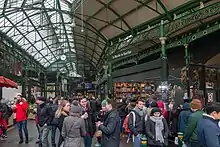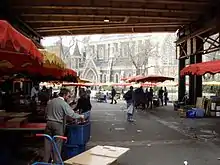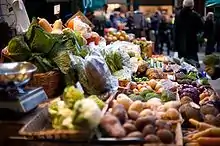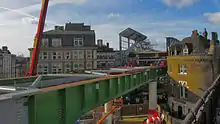Borough Market
Borough Market is a wholesale and retail market hall in Southwark, London, England. It is one of the largest and oldest food markets in London,[1][2] with a market on the site dating back to at least the 12th century. The present buildings were built in the 1850s, and today the market mainly sells speciality foods to the general public.

History

A market that originally adjoined the end of London Bridge was first mentioned in 1276, although the market itself claims to have existed since 1014 "and probably much earlier"[3] and was subsequently moved south of St Margaret's church on the High Street.[4] The City of London received a royal charter from Edward VI in 1550 to control all markets in Southwark (see Guildable Manor), which was confirmed by Charles II in 1671. However, the market caused such traffic congestion that, in 1754, it was abolished by an Act of Parliament.[5][6]
The Act allowed for the local parishioners to set up another market on a new site, and in 1756, it began again on a 4.5-acre (18,000 m2) site in Rochester Yard.[5][6] During the 19th century, it became one of London's most important food markets due to its strategic position near the riverside wharves of the Pool of London.[5]
In 2009, a group of "rogue traders", unhappy with Borough Market's administration and escalating rents departed to set up a new Maltby Street Market a mile away.
In the 2017 London Bridge attack, three attackers ran to the area, where they stabbed and killed people with knives before they were shot dead by armed police.[7] The market was then closed for 11 days following the attack.[8]
Information
Borough Market is located on Southwark Street and Borough High Street just south of Southwark Cathedral on the southern end of London Bridge.
The retail market operates Monday to Thursday from 10 a.m. to 5 p.m., Fridays from 10 a.m. to 6 p.m., and Saturdays from 8 a.m. to 5 p.m. The wholesale market operates on all weekday mornings from 2 a.m. to 8 a.m.
Architecture

The present buildings were designed in 1851, with additions in the 1860s and an entrance designed in the Art Deco style added on Southwark Street in 1932. Significant changes to the buildings have been made over the years as a result of successive expansions to the nearby railway infrastructure; see "Railway viaducts and the Thameslink Programme".
A refurbishment began in 2001. Work to date includes the re-erection in 2004 of the South Portico from the Floral Hall, previously at Covent Garden, which was dismantled when the Royal Opera House was reconstructed in the 1990s.[5] The original Convent Garden building was listed and the resited portico was Grade II listed in 2008.[9]
 Borough Market circa 1860
Borough Market circa 1860 Art Deco 1932 Southwark Street entrance
Art Deco 1932 Southwark Street entrance South Portico from the Floral Hall (erected 2004)
South Portico from the Floral Hall (erected 2004)
Trade
The present-day market mainly sells speciality foods to the general public. However, in the 20th century, it was essentially a wholesale market, selling produce in quantity to greengrocers. It was the main supplier, along with Covent Garden, of fruits and vegetables to retail greengrocers' shops. Amongst the notable businesses trading in the market were Vitacress, Lee Brothers (potato merchants whose signage can still be seen in the market), Manny Sugarman, AW Bourne and Eddy Robbins. JO Sims, the main importer for South African citrus fruit (Outspan), were also located in the market.

Stallholders come to trade at the market from different parts of the UK, and traditional European products are also imported and sold. Amongst the produce on sale are fresh fruit and vegetables, cheese, meat, game, baked bread and pastries.
The market is a charitable trust administered by a board of volunteer trustees, who have to live in the area.[10]
Borough Market and the surrounding streets have been used as a film location for such features as Bridget Jones's Diary (2001), Lock, Stock and Two Smoking Barrels (1998) and Harry Potter and the Prisoner of Azkaban (2004).[11] More recently some scenes in The Imaginarium of Doctor Parnassus (2009) were shot there.[12] As reported by the London Evening Standard, the market is available to hire for private events.[13]
Railway viaducts and the Thameslink Programme
From 1860, the railway operating companies desired to extend services from London Bridge station into new stations at Cannon Street and Blackfriars in the City and link to the West End at Charing Cross Station. This required a viaduct, but legally, it was impossible by the 1756 Borough Market Act for the Trustees to alienate their property. The compromise was that only a flying leasehold was given to the railway company for the permanent way, but only for as long as a railway operates on it. The Market continues to trade underneath the arches of the viaduct. Each time there is a railway expansion requiring widening of the viaduct, the Trustees receive a full compensation payment.[14]

Most recently, as part of the Thameslink Programme, a large number of listed buildings in the Borough Market area have been altered or demolished.[15] The market building on Bedale Street south-side has had its upper floors removed, as has the Wheatsheaf public house on Stoney Street, for the new railway bridge to cross over them. The remaining floors have been re-occupied. The old Market glazed roof on Stoney Street has been re-instated and cleaned. A significant loss was the Smirke Terrace, Nos 16–26 Borough High Street, demolished in 2010.[16]
See also
References
- "Food markets in London". Visitlondon.com. Retrieved 6 September 2012.
- Goldberg, Lina (24 February 2013). "10 of the world's best fresh markets". CNN Travel. Retrieved 24 February 2013.
- The History of Borough Market Archived 8 August 2011 at the Wayback Machine Borough Market website
- "Borough Market". On London Time. 30 May 2011. Archived from the original on 10 September 2012. Retrieved 6 September 2012.
- "Borough Market Tourist Info". London-traveltips.com. 7 December 2011. Archived from the original on 27 June 2012. Retrieved 6 September 2012.
- "About Us - History". Borough Market. Archived from the original on 19 February 2012. Retrieved 6 September 2012.
- "BBC News Live". Retrieved 3 June 2017.
- "Borough Market reopens 11 days after London Bridge attack". Retrieved 26 May 2018.
- Historic England. "RESITED FLORAL HALL PORTICO AT BOROUGH MARKET (1392690)". National Heritage List for England. Retrieved 3 December 2016.
- "About Us - The Trustees of The". Borough Market. Archived from the original on 19 February 2012. Retrieved 6 September 2012.
- Julian Clinton. "Location Information - Borough Market". Where Did They Film That. Retrieved 6 September 2012.
- "17 London Airbnbs for under $150 a night - thelocalvibe Airbnb rankings". thelocalvibe. 19 September 2018. Archived from the original on 12 October 2018. Retrieved 11 October 2018.
- "Borough Market sets out its stall as a venue to get married". London Evening Standard. Retrieved 6 February 2014.
- "Underneath the Arches: Celebrating Borough Market". History Today. 1 April 2014.
- "Save Borough Market Area Campaign: FAQ". Archived from the original on 7 September 2008. Retrieved 15 August 2008.
- "Borough High Street: Conservation area appraisal" (PDF). 1 June 2006. p. 28.
External links
| Wikimedia Commons has media related to Borough Market. |
